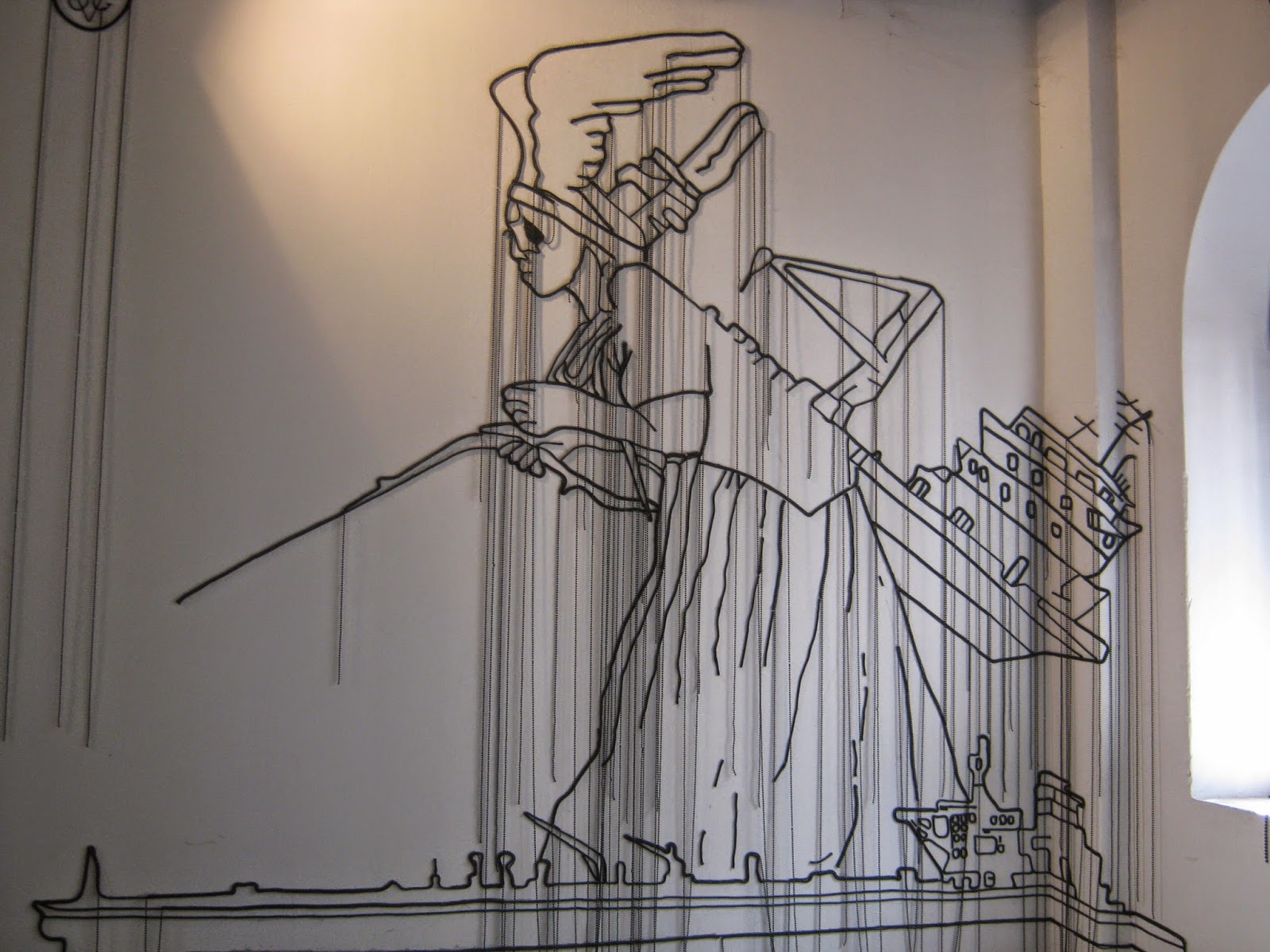What a way to begin a year! Last Sunday I made my pilgrimage to the altar of art that is the Kochi- Muziris Biennale 2014, the second edition of art extravaganza that is bigger and better than the last one. As usual, since our spouses are totally averse to the idea of tramping around looking at art and since kids would only be a distraction, it was another girls' day out for my dear friend Tessa and me. This time I worked my camera to bits: a whopping 400+ photos as opposed to the 100+ last time. This was because when I came back home last time and started to blog, I found that I could not remember the names of even half a dozen creators of the works that I loved the best. So this time, I took pictures of all the artist names and descriptions regardless of whether their work impressed me or not. At least I have a better record now!
The tickets to the Biennale are available at the second entrance of the Aspinwall venue. For adults it is Rs100/person. The first exhibit this time around was a video installation by Charles and Ray Eames (of the Eames chair fame). It was a short film called Powers of Ten and for all that it was made in 1977, it was no less wonderful an experience. Let me just say that it puts us humans in place! Really timeless as true art should be.
The next thing that really caught my attention was a series of 90 charcoal drawings of Madhusudanan, called the Logic of Disappearance. Here is just one of them:
Lenin, Stalin, Marx and a pig are recurring motifs in the drawings and they are disturbing and breathtaking in their artistry at the same time.
Yang Zhenzhong's video installation 922 Rice Corns reminded me of the old Sesame Street videos that teaches numbers to preschoolers. It shows two or three chickens pecking up grains of rice while someone counts the rice corns in the background in Chinese and the a few running counters show the number already pecked. Although the blurb said that it was a way to show the relentless and mindless consumption tendencies of humans, I just felt that it was a good way to learn to count to 922 in Chinese. But may be I do not have the artistic temperament!
I loved Santhamani Muddayya's Backbone that dominated the courtyard of Aspinwall House. Don't you?
It's raw and primordial and still playful, somehow. These are the feelings it evoked in me and I took pleasure in passing between the "bones".
Parvathi Nayar's drawings on wooden panels were also very good. An example:
Mark Formanek's Standard Time was a video installation that was every bit thrilling as a real movie.
It shows a group of workers changing some numbers (another throwback to Sesame Street?), but then you realize: the numbers are a time display, it is the same time on your watch, the workers are hurrying to change the time within each minute!!! And then you feel anxious about whether they will accomplish the necessary changes within the minute and spend an agonizing time watching (in my case) the second hand of your watch! Really what better a way to show the tyranny of time??? I heaved a huge sigh of relief as I came out of that room, I can tell you!
Lavanya Mani's Traveller's Tales was another of my favorites:
Actually the architects of Aspinwall House should be mentioned among the artists. Who cannot but admire this?
Here I will skip over quite a few artists to get to my next favorite installation, a roomful of towering black, seemingly dripping outlines on white by Hew Locke called Sea Power:
It was only as I went up closer that I found out how it was done!
Yes, they are made with thick cord and strings of bead, attached with a glue gun to the walls. A man after my own heart, is Hew Locke!!!
Sahej Rahai had a huge hall full of sculptures made from clay and found objects, most of them were from the school of the macabre:
But the one not to miss is the video installation at one end of this hall - that of an old sculpture that looks quite still and innocent until you see small furtive movements. The stone chest moves in an attempt to breathe, then it tries to stretch its back! By the time its damaged face moved as though desperately trying to speak, I fled!!! Brrr!!!
The one piece that truly surprised and confounded me was Xu Bing's Background Story: Endless Xishan Mountain Scenery. The placement of this artwork aids this confusion. Tessa who had already seen this piece hung back on purpose to let me have my first glance:
What do you see? A frame of fluorescent tubes, a lot of torn paper, some dried vegetation, a few twigs, huh? I shook my head derisively at who ever had thought of this as "art" and went around where I stood and gaaaaaaaped.....
Tessa quite enjoyed my open-mouthed expression. All the junk at the back is artfully arranged so that the shadow is projected on to the canvas to create this wonderful painting. To look at a little detail... this is the view from behind...
and this is what it looks like from the front:
The original of this huge piece of art is displayed in a glass case nearby:
It was tough getting the huge piece in one shot:
So on that note of wonder, let me put an end to this episode of the Biennale. The exhibition goes on to the end of March (the last date is the 29th, I believe). If you can, do go and see these wonders for yourself! Enjoy!





















No comments:
Post a Comment